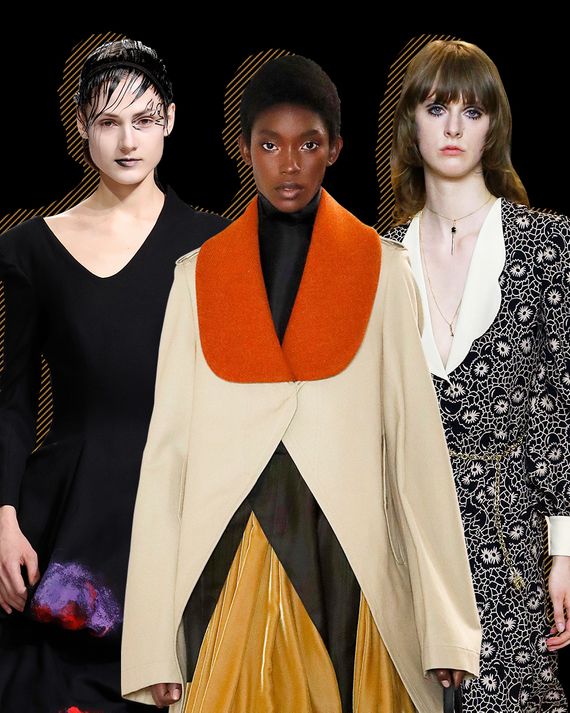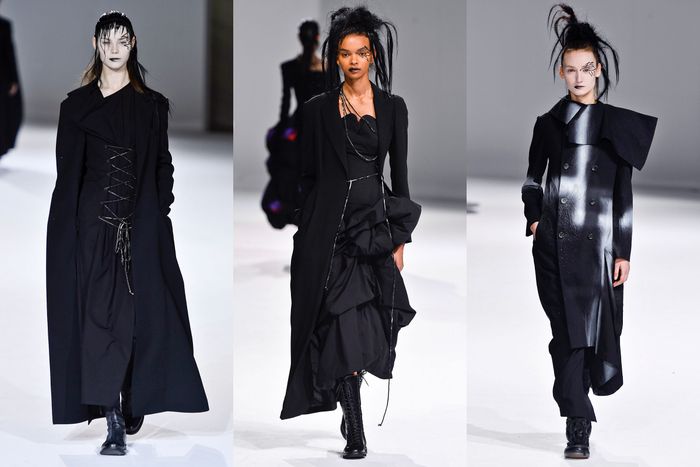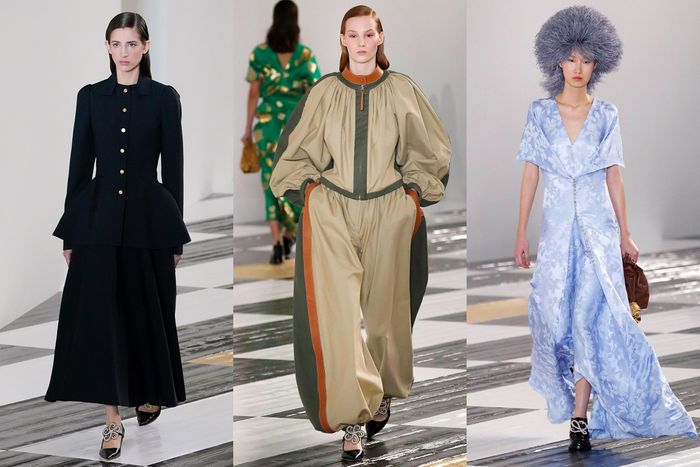
Hedi Slimane kept Celine firmly planted in the Parisian ’70s — quelle surprise. Jonathan Anderson withdrew to the interwar and postwar years in Spain for Loewe’s esoteric volumes, explaining, “We have to push it somehow.” Yohji Yamamoto, the old man in this group, decided to hold a dialogue between the 19th and 21st centuries, beginning with the most symbolic of feminine trappings — the corset and petticoat.
Yamamoto has lately become my obsession. Of course, I went to his shows in the late ’80s, the ’90s, and the early aughts, when you couldn’t afford to miss him. But I stopped when the collections started to seem repetitive and the Paris calendar filled up with newer names and glitzier shows. I go now because he is essentially speaking in a whisper and I want to catch the minor vibrations in a lifetime of major form. I go because the occasion feels meditative rather than informative: a plain runway, folk music, a model walking slowly out in black trousers, her black coat and vest loosely laced with corset ties. Other black outfits featured full, billowy skirts, their mass sometimes seeming to punch through the strict line of a coat, as if trying to escape the past and enter the future.
This was, of course, the path that feminine fashion took at the start of the 20th century, when women finally jettisoned corsets and petticoats, then began in the 1920s to wear the short looks proposed by Chanel and other Paris designers. Trousers followed. Part of Yamamoto’s genius is that he can imply these time-shifts without actually leaving the present or using anything other than modern fabrics. His work is also a reminder of the power of silhouette. I look at a slim black coat with one part of the collar popping out sideways — whee! — and chalky smudges of white down the front, and I see an illustrator, a Joe Eula, capturing the whole effect in a single brisk line. The smudges could be those of a fading photograph.
Slimane is a genius in his own way. Someone I know raised the question last night on Twitter: Why review Celine if it’s just “clothes” he’s showing? I think, to the contrary, he is showing what will be fashionable in 2020–21. He is not pushing any envelopes with his classic blazers, trenches, pea jackets, pretty crêpe de chine blouses, and gaucho pants, all with tasteful gold jewelry. For he knows that we live in a world that has less patience now for esoteric and “difficult” fashion. Until the 21st century, there were retailers and journalists who could help consumers appreciate the latest fashion. They could translate it, as a new exhibit on Harper’s Bazaar (at the Musée des Arts Décoratifs) makes clear.
But that system has broken down, with social media and big luxury brands, with their leveling effects, causing the final disintegration. Be honest: Could radical designers like Yamamoto and Rei Kawakubo have made it in the ’80s without the press wearing and explaining their ideas?
So I think Slimane is only too aware of these changes. Additionally, the specific fit of the Celine collection — the achingly tight unisex pants, the relaxed but unsloppy attitude of the sportswear, the sparkly but simply cut cocktail looks — also puts it in fashion. There’s a generation of young consumers who want what they want, instantly and without irony. A little bit of chic doesn’t hurt, either.
Oh, I fret when publicists drop words like “extremized.” Is that a word? I don’t think so. Anyway, it turned up in the show notes for Loewe, a quite lovely collection that mostly conjured words like “dressmaker” and “sartorial.” Because Loewe is a Spanish leather-goods house (owned by LVMH), we get to see Anderson’s reflections on that culture. And it’s a huge, rich culture for fashion, not only in the Cristobal Balenciaga era.
Anderson said he was intrigued by how Spanish dressmakers, say, in the ’30s and ’40s, looked to Paris or New York for influence, then interpreted styles for their market, often in fabrics that were available. The strongest looks in the show were a trio of body-skimming dresses in rose, green, or frosty blue silk, with a subtle caped effect at the shoulders. In the same vein was a snug, dark wool peplumed jacket with a full, calf-length matching skirt.
Though some of the voluminous styles got away from Anderson — notably, a pair of enormous trousers that looked like men’s pants that had been taken in to fit a tiny lady, without cutting away the excess waistband and hips (diet pants!) — many other full shapes, especially sweeping coats, were a nice counter to the slim, elongating looks. Those were the best.
Still, thinking about the “extremized” gestures, I can’t help thinking of Yamamoto, the onetime king of volume, and wondering where Anderson will be in his head when he reaches the age that Yamamoto is today. What will he do when he no longer feels the need to “push” anything?





